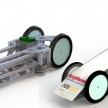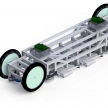
UCSB Hyperloop
Weightless. Wait less.
Description
The UCSB Hyperloop Team has created a futuristic vehicle that will travels through low-pressure tunnels, utilizing an aerodynamic design and magnetic levitation engines to maximize speed. The team has created a scalable design which they hope will prove the feasibility of using magnetic levitation engines to reduce friction with the ground. They will be taking their pod to compete against other teams from around the world at SpaceX’s Hawthorne campus this August. The goal of the competition? To be the fastest pod.
Hyperloop is UCSB Capstone’s largest interdisciplinary project, consisting of a team of electrical, computer, and mechanical engineers. The team works together to overcome the various challenges of the project, such as controlling the systems of the pod, supplying power to the numerous subsystems, and taking into account the staggering thermal implications of working in a near vacuum environment. These challenges could not be delegated to a single discipline and instead required collaboration between disciplines to be successful. The team is split into smaller task groups for each subsystem: structures, magnetic levitation, power distribution, sensors and controls, braking, and thermal. Here is a brief overview of each subsystem:
Structures:
Responsible for design and fabrication of pod frame. They came up with an innovative “cart-payload” design that features a stable, wheeled cart that carries a payload that levitates using magnetic engines. This design provides maximum stability while still utilizing the thrust from the maglev engines to reduce the perceived weight of the pod.
Magnetic Levitation:
Responsible for characterizing the magnetic levitation engines. There is not much available information on maglev engines, so the maglev team compiled all the necessary information through rigorous testing. They created stationary and translational test rigs in order to characterize the engine behavior under all conditions.
Power Distribution:
Responsible for powering the subsystems of the pod. One of the major challenges the team faced was supplying power to the maglev engines, which draw a combined 200A when running. On top of this, the several actuators and controller also need to be powered. The power distribution team made this possible through the design of several battery banks, which are able to be monitored and controlled by the controller.
Sensors and Controls:
Responsible for controlling all the subsystems of the pod, as well as making decisions to ensure the pod has safe behavior. Each subsystem requires various control signals and needs to be monitored to ensure behavior is acceptable. To achieve this, the team fabricated tens of printed circuit boards that consolidate the number of locations signals needed to be sent to. In addition, the controller has been programmed to make decisions based on the feedback it collects, as well as respond to commands issued wirelessly.
Braking:
Responsible for brake design and actuation. SpaceX has issued very strict specifications for the braking behavior they will accept, so the braking team worked hard to create a design within the given constraints. Because the pod can only go as fast as it can safely brake, the braking team designed a system of parallel clamps that will utilize friction to slow the pod.
Thermal:
Responsible for ensuring all components can withstand the strain of functioning in a low pressure environment. Without air to dissipate heat, components will begin to heat up much faster. This was one of the largest challenges the Hyperloop team faced. The thermal team worked with every other subsystem team to ensure that the extra heat was within acceptable parameters; if it wasn’t, they designed efficient methods for sinking the heat to ensure everything would function.
Through their collaboration, each member of the team has become well acquainted with each discipline and grown aware of the numerous considerations that need to go into a project of this magnitude. Each subsystem underwent thorough investigation before realization, thanks to the feedback from experienced mentors on campus as well as industry experts. UCSB Hyperloop has pulled out all the stops this year and is prepared to make an impact at the international SpaceX competition.











